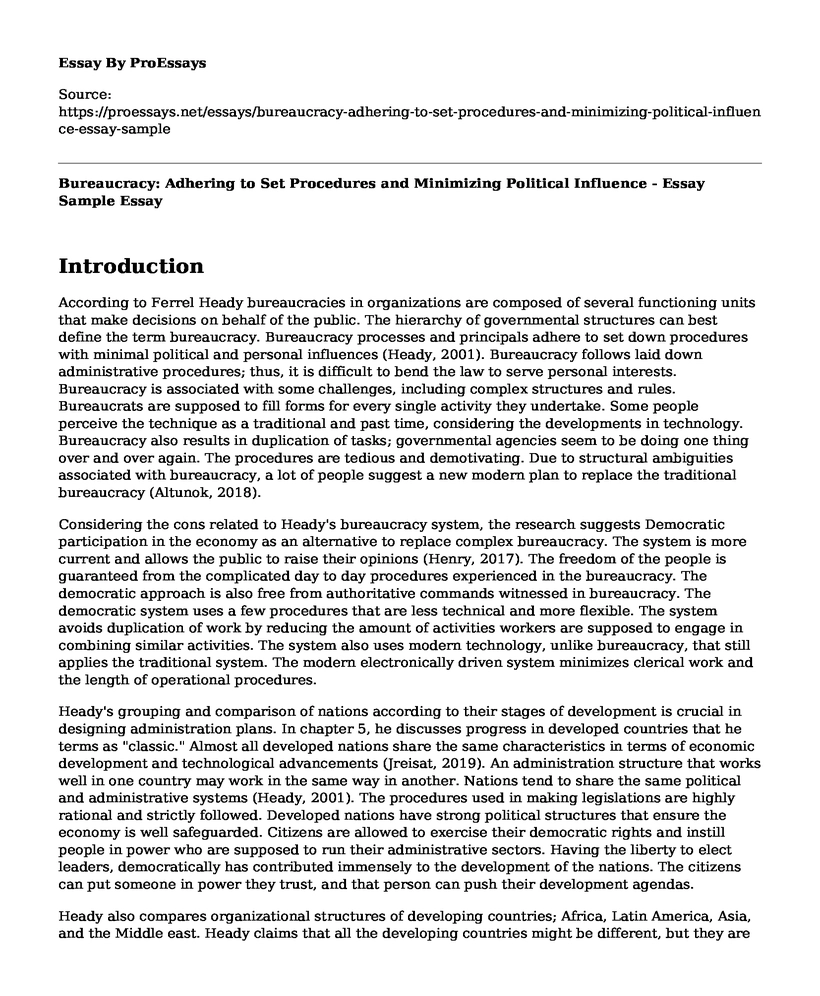Introduction
According to Ferrel Heady bureaucracies in organizations are composed of several functioning units that make decisions on behalf of the public. The hierarchy of governmental structures can best define the term bureaucracy. Bureaucracy processes and principals adhere to set down procedures with minimal political and personal influences (Heady, 2001). Bureaucracy follows laid down administrative procedures; thus, it is difficult to bend the law to serve personal interests. Bureaucracy is associated with some challenges, including complex structures and rules. Bureaucrats are supposed to fill forms for every single activity they undertake. Some people perceive the technique as a traditional and past time, considering the developments in technology. Bureaucracy also results in duplication of tasks; governmental agencies seem to be doing one thing over and over again. The procedures are tedious and demotivating. Due to structural ambiguities associated with bureaucracy, a lot of people suggest a new modern plan to replace the traditional bureaucracy (Altunok, 2018).
Considering the cons related to Heady's bureaucracy system, the research suggests Democratic participation in the economy as an alternative to replace complex bureaucracy. The system is more current and allows the public to raise their opinions (Henry, 2017). The freedom of the people is guaranteed from the complicated day to day procedures experienced in the bureaucracy. The democratic approach is also free from authoritative commands witnessed in bureaucracy. The democratic system uses a few procedures that are less technical and more flexible. The system avoids duplication of work by reducing the amount of activities workers are supposed to engage in combining similar activities. The system also uses modern technology, unlike bureaucracy, that still applies the traditional system. The modern electronically driven system minimizes clerical work and the length of operational procedures.
Heady's grouping and comparison of nations according to their stages of development is crucial in designing administration plans. In chapter 5, he discusses progress in developed countries that he terms as "classic." Almost all developed nations share the same characteristics in terms of economic development and technological advancements (Jreisat, 2019). An administration structure that works well in one country may work in the same way in another. Nations tend to share the same political and administrative systems (Heady, 2001). The procedures used in making legislations are highly rational and strictly followed. Developed nations have strong political structures that ensure the economy is well safeguarded. Citizens are allowed to exercise their democratic rights and instill people in power who are supposed to run their administrative sectors. Having the liberty to elect leaders, democratically has contributed immensely to the development of the nations. The citizens can put someone in power they trust, and that person can push their development agendas.
Heady also compares organizational structures of developing countries; Africa, Latin America, Asia, and the Middle east. Heady claims that all the developing countries might be different, but they are all caught in the wave of drastic change in social change. All the developing nations are moving from the traditional phase to the new stage. Heady claims that all developing countries share the same ideology of development; they all strive to become better in terms of economic development and technology advancement. Developing countries are in a state where they want to become better. The nations want to prosper economically and tackle some of the problems faced, such as poverty. Inadequate technical know-how and facilities limit growth in developing nations. However, both developed and developing nations have established systems of administration; the bureaucratic system is commonly used.
References
Altunok, H. (2018). Bureaucratic Red Tape. Global Encyclopedia of Public Administration, Public Policy, and Governance, 1-4. https://doi.org/10.1007/978-3-319-31816-5_3517-1
Heady, F. (2001). Public Administration, A Comparative Perspective. CRC Press.
Henry, N. (2017). Toward a Bureaucratic Ethic. Public Administration and Public Affairs, 500-511. https://doi.org/ 10.4324/9781315530536-17.
Jreisat, J. E. (2019). Administration of Developed Systems. Comparative Public Administration and Policy, 135-163. https://doi.org/10.4324/9780429037238-6
Cite this page
Bureaucracy: Adhering to Set Procedures and Minimizing Political Influence - Essay Sample. (2023, Mar 13). Retrieved from https://proessays.net/essays/bureaucracy-adhering-to-set-procedures-and-minimizing-political-influence-essay-sample
If you are the original author of this essay and no longer wish to have it published on the ProEssays website, please click below to request its removal:
- Essay Sample on Deconstructing America
- Rhetorical Analysis of President Barack Obama's Second Inaugural Address
- Essay Sample on Photographic Socialism
- Essay Sample on Curriculum Relevance in Multicultural Societies: Standardizing Knowledge
- Essay Example on Congress' Power to Tax for Common Defence and Welfare
- Essay Example on Police, Charter of Rights: Upholding the Law of the Land
- Donald Trump Tries to Erase Tweets Blasting Journalists on Coronavirus Response - Essay Sample







